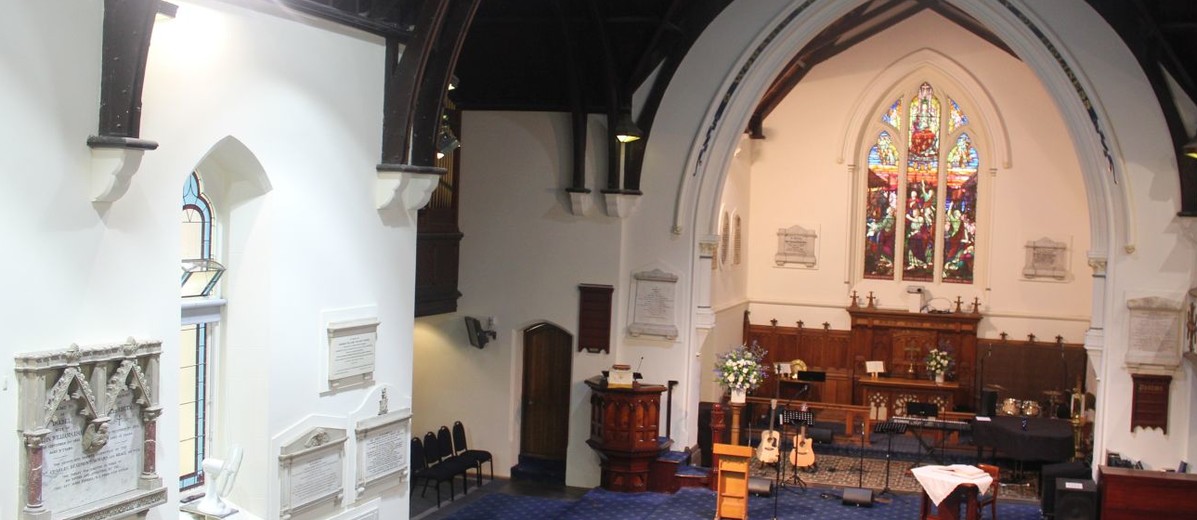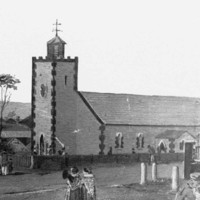Originally known as Trinity Church, Holy Trinity Church is the earliest surviving Anglican Church building in South Australia, and one of Adelaide’s oldest standing structures. It was allocated Town Acre Nine of Colonel William Light’s original city plan, and built over a seven-month period in 1838. The church was often the preferred place of worship for the military and prominent members of the colony, including successive governors and their families. Over the course of its 176-year existence, Holy Trinity Church has been rebuilt a number of times, with the last major construction/renovation episode occurring between 1888 and 1889. Today it hosts a sizable conservative evangelical Anglican congregation and the largest weekly attendance of any Anglican church in South Australia.
Origins
Proposals to establish a new colony along the south coast of Australia prompted members of the Church of England to contribute to its creation, settlement and support. In 1834, prominent Church of England members Raikes Currie and Pascoe St Leger Grenfell established the South Australian Church Committee and began soliciting funds to support the creation of an Anglican congregation in the fledgling colony. With support of both the Bishop of London and the British-based Society for Propagation of the Gospel, the South Australian Church Committee was able to raise approximately £800. The Committee was also permitted to select the government-sanctioned Colonial Chaplain who would minister to the formal religious needs and instruction of the colonists. After a lengthy search, the Reverend Charles Beaumont Howard—an Irish graduate of Trinity College, Dublin—was nominated to the role.
In an effort to hold Trinity Church’s funding and property in perpetuity, the South Australian Church Committee entered into an agreement with three prominent Anglican members of the colony: James Hurtle Fisher (Resident Commissioner), Osmond Gilles (Colonial Treasurer) and Charles Mann (Advocate General). Under the agreement, each man and his respective successors would serve as trustees to the church, and nominate clergy to minister to the congregation. Land acquired by Grenfell comprising a one-acre block within the city and 40 country acres was gifted to the Committee and included in the trust.
Reverend Howard’s duties as Colonial Chaplain commenced when he boarded HMS Buffalo in late July 1836. During the voyage, he performed religious services on Sunday, and officiated over marriages and baptisms. Upon Buffalo’s arrival at Holdfast Bay on 28 December 1836, Howard assisted Governor John Hindmarsh with swearing-in of the colony’s officials at the proclamation ceremony. On the following Sunday, he conducted his first official church service on the beach at Glenelg.
The First Anglican Church ‘Buildings’
The original plan adopted by the South Australian Church Committee was to ship two prefabricated wooden structures to South Australia, where they would be erected and function as the colony’s first Anglican house of worship and Colonial Chaplain’s residence, respectively. The church building was described as ‘handsome’ in appearance and capable of accommodating 750 congregants. It cost £400 and was sent to South Australia aboard the vessel William Hutt. Upon arriving at Holdfast Bay, William Hutt’s crew offloaded the components of both buildings and left them on the beach, where they quickly deteriorated due to a combination of exposure to the elements and their flimsy construction. To complicate matters, there was a lack of tradespeople to move and assemble each structure, and tools and other necessary equipment were in short supply.
Ultimately, Howard abandoned the prefabricated buildings, acquired a sail from one of the vessels anchored in Holdfast Bay, and jury-rigged a tent on North Terrace. It was under this very basic shelter that he conducted his first church service in Adelaide. Within a very short time, the congregation moved to a simple wooden building that also served as the colony’s temporary courthouse. Howard recognised that a permanent structure was needed to house his flock, and in June 1837 launched an appeal in the local press for funding to construct a new stone church.
A Permanent Home
Construction of Trinity Church commenced with the placement of a lead foundation plate by Governor Hindmarsh on 26 January 1838. On the plate were etched the words ‘The Lord of Heaven he will prosper us; therefore we his servants will arise and build. Nehemiah, ii.20’. John White was contracted to build the church. He followed a simple English village church design and anticipated it would take two months to erect. The church’s location was Town Acre Nine, at the corner of North Terrace and Morphett Street. Originally quoted at £1100, the church ultimately cost £2400 to complete, partly as a consequence of the inclusion of a clock tower with ‘peaked cap’ and Vulliamy clock. The clock was built by Benjamin Lewis Vulliamy, a highly regarded clockmaker who manufactured timepieces for King William IV. Vulliamy’s clock and its tower were added to the church on the orders of the Colonial Commissioners, who intended that it function as Adelaide’s town clock.
The site on which Trinity Church was situated was selected by Surveyor-General Colonel William Light in March 1837 as part of the original lot-drawing process from which the city’s land-order holders acquired their town acres. In an effort to ensure an objective decision, all land-order applicants agreed that Light should select the church’s location. Its placement was based on his supposition that Morphett Street would be the city’s primary crossing point over the River Torrens, and therefore the hub of commercial and government activities as the city developed. In fact, Adelaide’s power base ultimately centred on Government House and King William Street, leaving Trinity Church in an area soon characterised by secondary industry and modest housing.
Contrary to builder John White’s claim that Trinity Church would be finished in two months, seven months passed before it was completed. During this time, Howard ministered to his congregation in the uncompleted building—often while construction activities were taking place around them. In the long term, White’s work proved faulty and the church had to be rebuilt in 1845. In the short term, other issues—primarily financial in nature—plagued Howard and his congregation. The British government’s decision to cut funding to South Australia in 1841 resulted in an economic crisis so severe that Howard could not repay bank loans acquired during construction of the church. Faced with foreclosure, he offered to sell the church building to the South Australian government for £2000, but was turned down by Governor George Grey. A second threat of foreclosure loomed in mid-1843, but the church survived this as well. Tragically, Howard fell ill and died at the height of the crisis. He was replaced by Reverend James Farrell, another graduate of Trinity College, Dublin.
First Renovation
In November 1844, the walls and tower of Trinity Church developed several large cracks that rendered the building unsafe. The church was closed at the beginning of the following month and the congregation moved to St John’s Anglican Church on the eastern side of the city. Renovations—including an increase in the height of each transept’s walls and roof, replacement of the clock tower’s tall ‘peaked cap’ with a smaller pyramid-shaped cover, enlargement of the nave, and removal of the vestry to a new location—were carried out by a Mr RG Bowen and Mr White. It is interesting to note that the latter contractor may have been the same John White who did such a poor job building the original church, while Mr Bowen had to defend his professional reputation against concerns the new roof was ‘insufficiently trussed’. Golden-coloured limestone used to construct the church was sourced from the same quarry that supplied building material for Government House and Old Parliament House. The renovated church also shared Old Parliament House’s red brick quoining. Reverend Farrell reopened Trinity Church for services on 10 August 1845.
Adelaide’s first bishop, Augustus Short, was installed in a ceremony at Trinity Church on 30 December 1847. In July of the following year, Short consecrated the church and designated it his temporary cathedral. He also appointed Reverend Farrell to the position of Dean of Adelaide's diocese. Historical records reveal that in the wake of Short’s arrival, the church was first referred to by the name it bears today: ‘Holy Trinity Church’.
Second Renovation
During the late 1870s, the trustees of Holy Trinity Church proposed rebuilding the existing structure; however, another decline in South Australia’s economy delayed the initiative until October 1888. On 14 October a final service was held in the ‘old’ church building and the congregation (once again) temporarily relocated to another space. Noted Adelaide architect Edward John Woods commenced re-inventing the church building in the ecclesiological Gothic Revival style it exhibits today. His ideas were executed by a Mr Cobb, who was awarded the construction contract. The height of the nave and gables were increased by two metres and five metres, respectively, while the tower was raised approximately six metres. Today, these alterations are easily distinguished by the colour difference of the stone used in each construction phase. In addition, the dimensions of the chancel and transepts were expanded. Buttresses all but masked the building’s original quoining, and the tower’s pyramidal cover was removed and replaced by four spirets and a vane. Within the church the existing ceiling was raised and complemented with fine timber work. The newly-renovated Holy Trinity Church resumed services in 1889. Its architecture has not been substantially altered since.
Holy Trinity Church Today
Holy Trinity Church is still home to an Anglican congregation, and has had an unbroken association with the Church of England since its establishment in 1838. Today, the church forms part of a complex that includes a number of historic and modern structures, including the former Rectory (1851), Parish Hall (1886-1887), cottage (1952), CB Howard office building (1960), and childcare facilities contained within the James Farrell Building (1966). The original schoolhouse was built of stone and brick between 1846 and 1847, and expanded in 1855. It remained in use until 1932 when it was demolished.

Hi Linnea, unfortunately James is no longer working with the History Trust. You can see where he found the information for this article by clicking on the Sources tab. If you are looking for Anglican Church records in South Australia a good place to start is here: https://adelaideanglicans.com/diocesan-archives/
hello james, I have been reading your article. I wondered if you had any info on my ancestors harriet and Charles emery. they were very involved with this church my research has shown. would you know if this church kept records of them. Charles was a bell ringer and it is said he run the bell at col lights funeral ???? or how I could contact the church for records. thank you. any help would be appreciated.
Dickey, Brian, Holy Trinity Adelaide, 1836-2012: The history of a city church (Adelaide: Trinity Church Trustees Inc., 2013).
Dickey, Brian, Holy Trinity, Adelaide’s pioneer church: A brief history (Adelaide: Holy Trinity Anglican Church, 2011).
Dickey, Brian, ‘Starting the first Anglican church in Adelaide’, Trinity Times: The magazine of Holy Trinity Church, Adelaide, December 2006.
Dickey, Brian, ‘Post war church dynamics: Holy Trinity, Adelaide (1946-73) as a case study’, Lucas: An Evangelical History Review 5, 1989, pp. 23-28.
MacGillivray, Leith, ‘A Worthy Sisterhood’: Pictures of birth, death and marriage from among immigrant women to South Australia in 1836’, unpublished lecture presented to the Historical Society of South Australia, November 1999.
South Australian, 10 December 1844, ‘St. John’s Church’, p. 3.
South Australian Gazette and Colonial Register, 12 August 1837, ‘Episcopal Church’, p. 3.
South Australian Gazette and Colonial Register, 20 January 1838, ‘Trinity Church’, p. 3.
South Australian Register, 12 July 1845, ‘Trinity Church Roof’, p. 2.
The Perth Gazette and Western Australian Journal, 14 October 1837, ‘South Australia’, p. 990.
The Sydney Monitor, 11 April 1838, ‘South Australia’, p. 3.




Add your comment